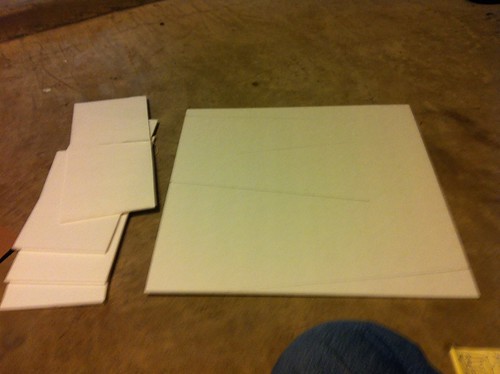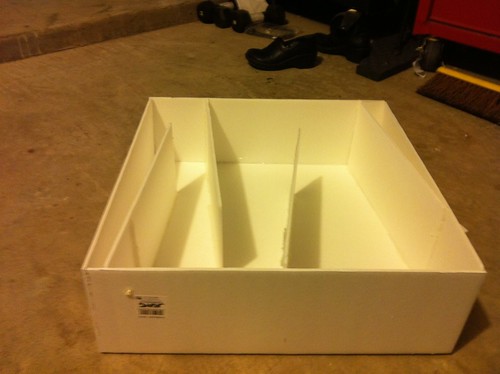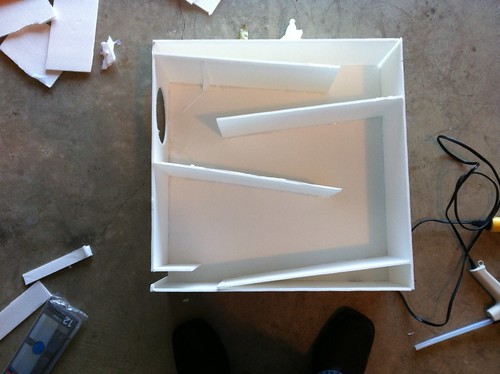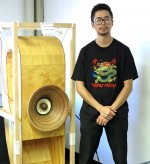Wesayo,
the thread says it is a TL - I wonder what it looks like inside? Probably a spiral of some sort. Good to see they like the Vifa TC9FD! My favorite all purpose driver.
It should be my favourite too
For the vent, the brace is obstructing it, I'd probably want to adjust things a bit accordingly. I'd cut the vent on an angle, with the entrance at the end of the "TL", such as it is, and the exit closer to centered on the panel. This would expand the size of the entry and exit of the vent, much like a flare, and also give the vent entrance a little more breathing room.
Badman,
The port is 1.33 in from the brace as you call it. The circumference x 1.33 in gap is 8.36 sq inches. The CSS of the port is 3.142 sq inches. The ratio of circumferential area to CSS is 2.66. Isn't that enough margin to allow free flow?
Probably okay, it looks pretty tight though.
That's after the Cialis?
Ouch!
Lmao!!!
X.....you have created a monster.
I finally found an hour of free time this afternoon, getting the twins first birthday behind me and all the family that involves. One hour, including setup, build, and cleanup. Simply freaking awesome.
A triple-fold TQWP, 60" long, for a 40-1354. If it works like I think it will, it and its twin are going in my four year olds room so that Radio Disney and her CD's are played in her room...not in the family room. Win/win if I have ever seen one.




I finally found an hour of free time this afternoon, getting the twins first birthday behind me and all the family that involves. One hour, including setup, build, and cleanup. Simply freaking awesome.
A triple-fold TQWP, 60" long, for a 40-1354. If it works like I think it will, it and its twin are going in my four year olds room so that Radio Disney and her CD's are played in her room...not in the family room. Win/win if I have ever seen one.




Very nice Motownman! It's like a folded Voigt pipe with the vent going forward. Make sure you add bracing strips to reduce the vibration of those larger spans of flat drumhead like areas. Rule of thumb is no more than a 3 to 4 in span on a flat without bracing. Vertical strips tying the two flat panels together are all you need.
Looking forward to first sound.
Good luck!

Looking forward to first sound.
Good luck!
Thanks X. Yeah, I have a bit more bracing to do but ran out of time when the babies woke up. I need to brace the driver area, put some angle pieces in the folds, and then some cross braces in the larger areas of the horn.
My next thought is wrapping the outside in the aluminum-faced asphalt sheeting from Home Depot. It is pressure-sensitive adhesive and would probably work very well damping vibrations. Might also be a waste of time and money...? I would think anything that added mass to the panels would be a good thing and especially one that would also double to absorb energy. Follow that with a wrap of very cheap 1/4" hardboard and a coat of chalkboard spray paint.
My next thought is wrapping the outside in the aluminum-faced asphalt sheeting from Home Depot. It is pressure-sensitive adhesive and would probably work very well damping vibrations. Might also be a waste of time and money...? I would think anything that added mass to the panels would be a good thing and especially one that would also double to absorb energy. Follow that with a wrap of very cheap 1/4" hardboard and a coat of chalkboard spray paint.
The asphalt will definitely add mass and damping to the walls but might be heavy and expensive. Don't know what it costs. Here is a damping method I developed and have tried on the baffle of a FC speaker and it absolutely absorbs a lot of energy and is cheap: use plumbers' putty and make little 1/4 inch dia balls out of it (lots of them). Then place the balls on the panel that you want to deaden the sound or vibrations at approx 1.5 to 2 inch center-to-center spacing. Need not be exact and squash the balls so they stick to the foam core panels (squash to about 1/8 in thick). Now, cut a foam core, or even better, a 1/4 inch chip board or masonite panel and place it over the putty-dotted panel making sure that all the squashed putty balls are in contact with the second panel and use hot melt to glue the edges of the panel to lock-in the putty balls. You can do this on the outside or inside. On the inside it is nice as you can't see it. It does an amazing job of stopping the vibration or sound from coming through. A jar of putty will cover a lot of surface area as only dots of it are used. The foam core cover panel is cheap and light weight.
I have 10 sheets of foam core and am starting to get itchy again.............. I need a new idea.
Don't think this has been posted yet - found it on a Burning Amp report. Appears to be suspended with rope.
Attachments
I am familiar with this and have been contemplating a FC version. It is in the Zen Acousta thread by Kohu. Looks like a picture of Kohu next to his creation. IIRC, this thing is a Lowther Field Coil powered unit with no stuffing and very smooth internal walls. Very cool looking though.
The asphalt stuff is easy to find right after a hail storm....just look for the roofing crews. I have a bunch left over as it works really good at deadening auto interiors too. Anywhere they have a lot of low-pitch roofs or really cold winters it is plentiful.
Home Depot carries it.
Home Depot carries it.
It should be on every house Cal has ever stepped in....I know it was code when I lived in Detroit. If you can find the aluminum backed stuff, it is almost the exact same thing as the high-dollar damping sheets.
Are you sure about that? I was under the impression the roofing kind was asphalt based while the damping sheets (at least the better ones) are butyl based. Butyl based damping sheets are way better in the long run as it does not dry out. The cheaper damping tiles usually are asphalt based though.
I have butyl based damping sheets in my car and they were a lot cheaper than the Dynamat brand. The stuff I use is Silent Coat and is a European brand.
You are both exactly right. However, the aluminum-backed product does not allow for much (if any) evaporative drying (one is supposed to tape butt joints with aluminum tape too). Also, I would only use this on the outside of an enclosure, covered by another layer of product and then hermetically sealed with paint.
Not the ideal material, by any means. But I think for this purpose, it might work fine. I will do a test panel with the sealing process and then hide it in my wife's closet. That will be the best test of my hypothesis...heh...
Not the ideal material, by any means. But I think for this purpose, it might work fine. I will do a test panel with the sealing process and then hide it in my wife's closet. That will be the best test of my hypothesis...heh...
Most of the roofing stuff has a thinner aluminium backing compared to the real damping tiles with butyl. I think to effectively use it you'd be better off with the real thing. Lot's of different brands selling the stuff at different prices. Shopping around helps. The butyl based stuff sticks very well and is very flexible.
No funny smells and great results on reducing panel vibration.
No funny smells and great results on reducing panel vibration.
- Home
- Loudspeakers
- Full Range
- Foam Core Board Speaker Enclosures?
